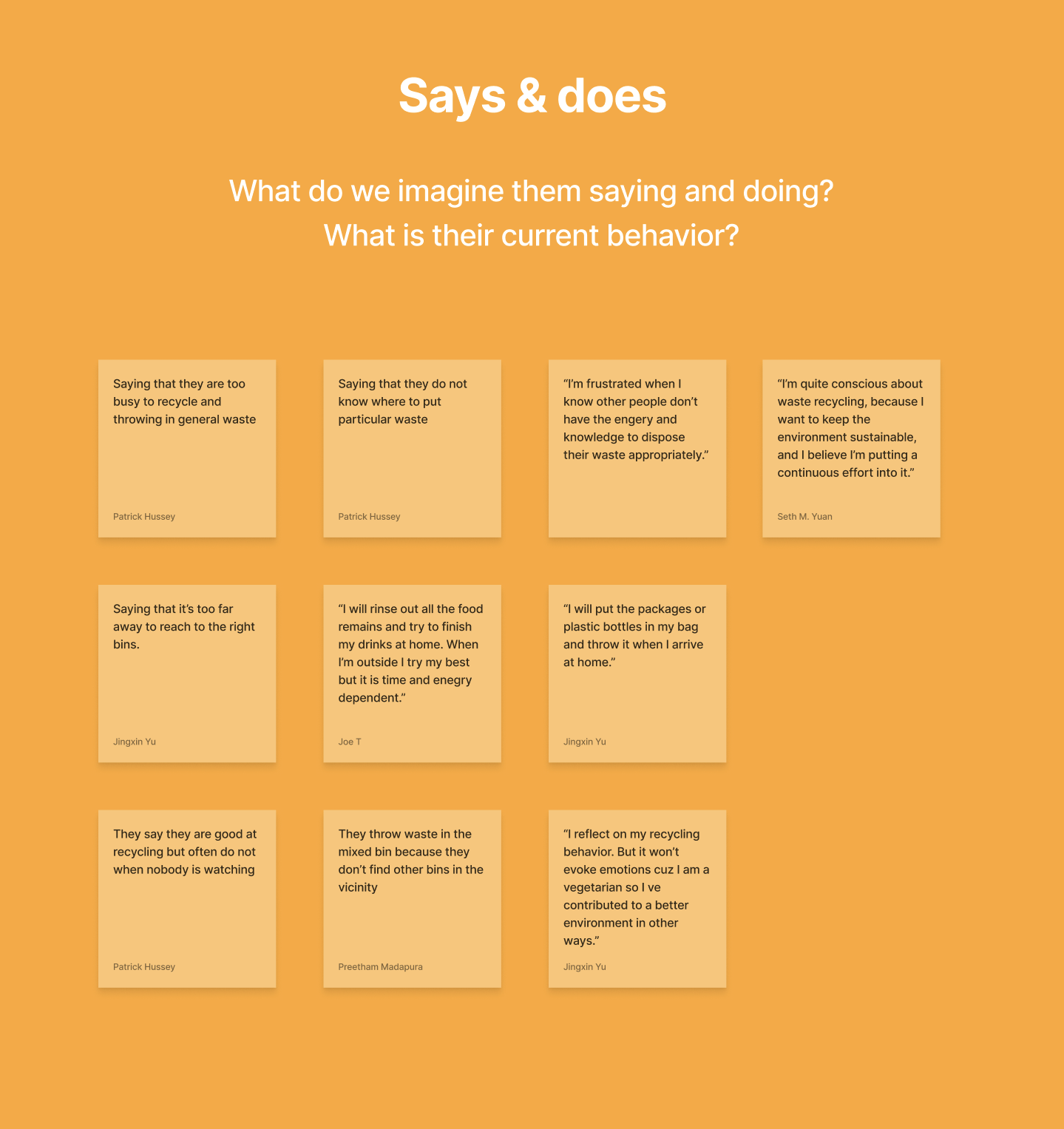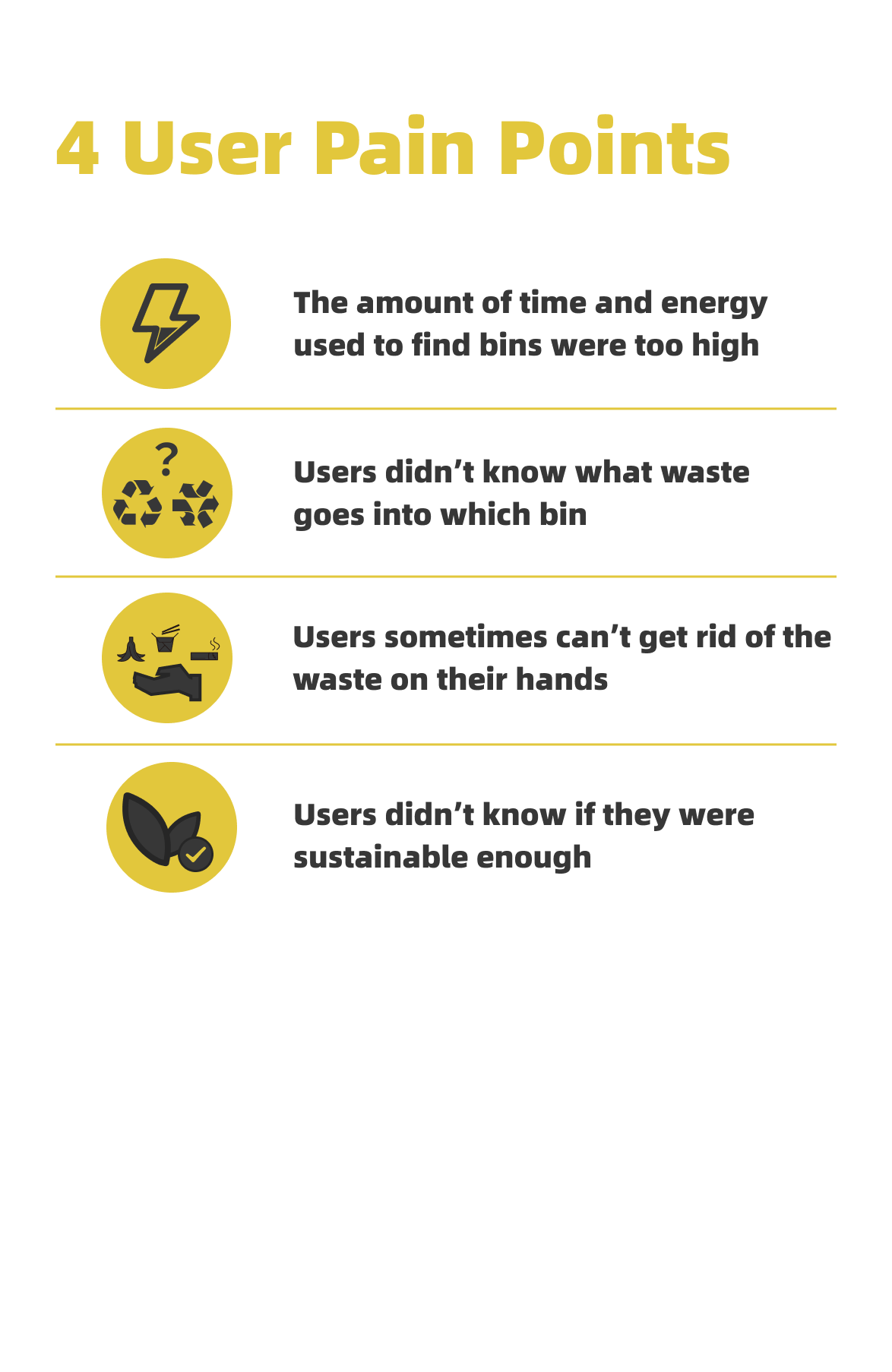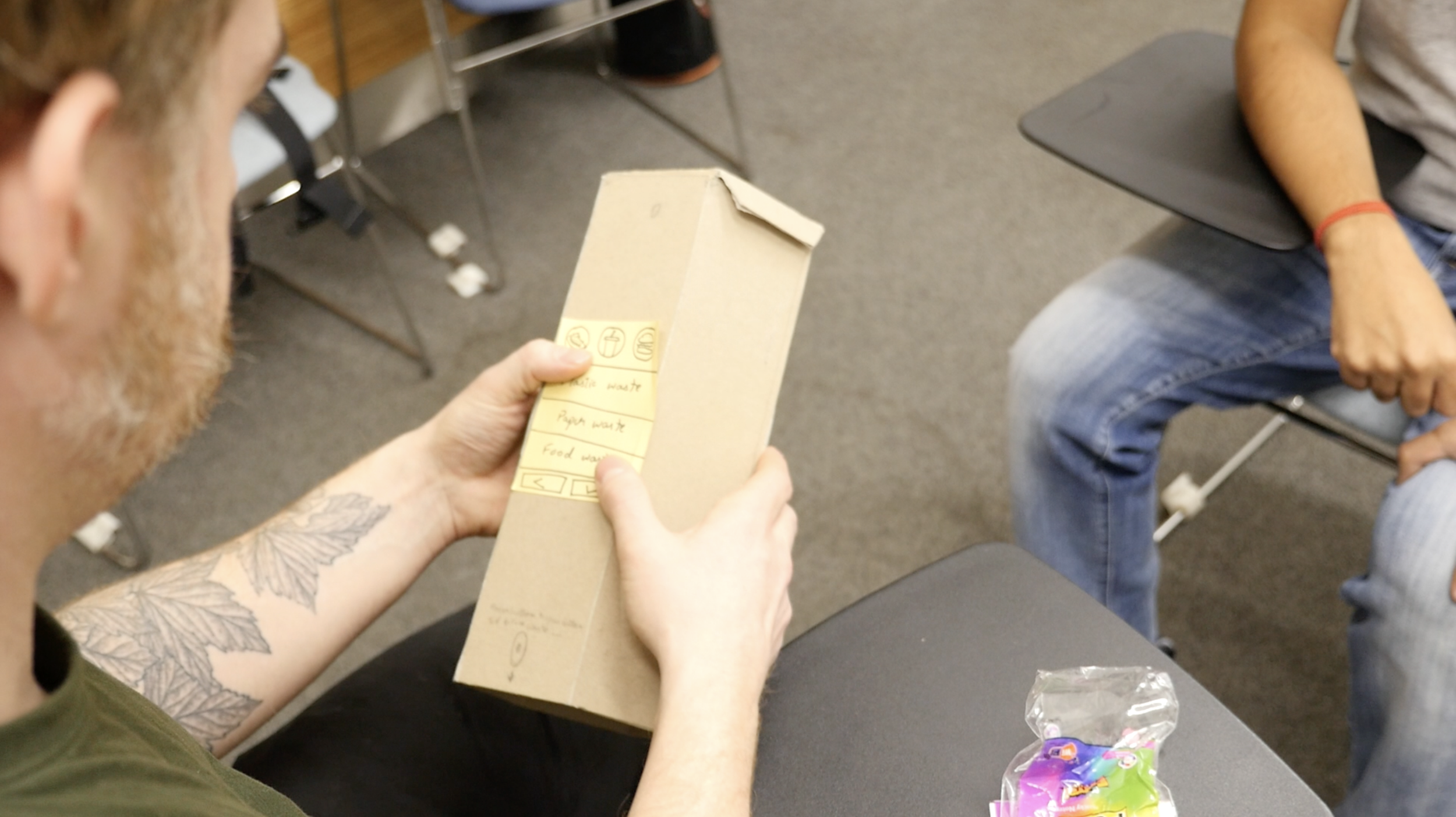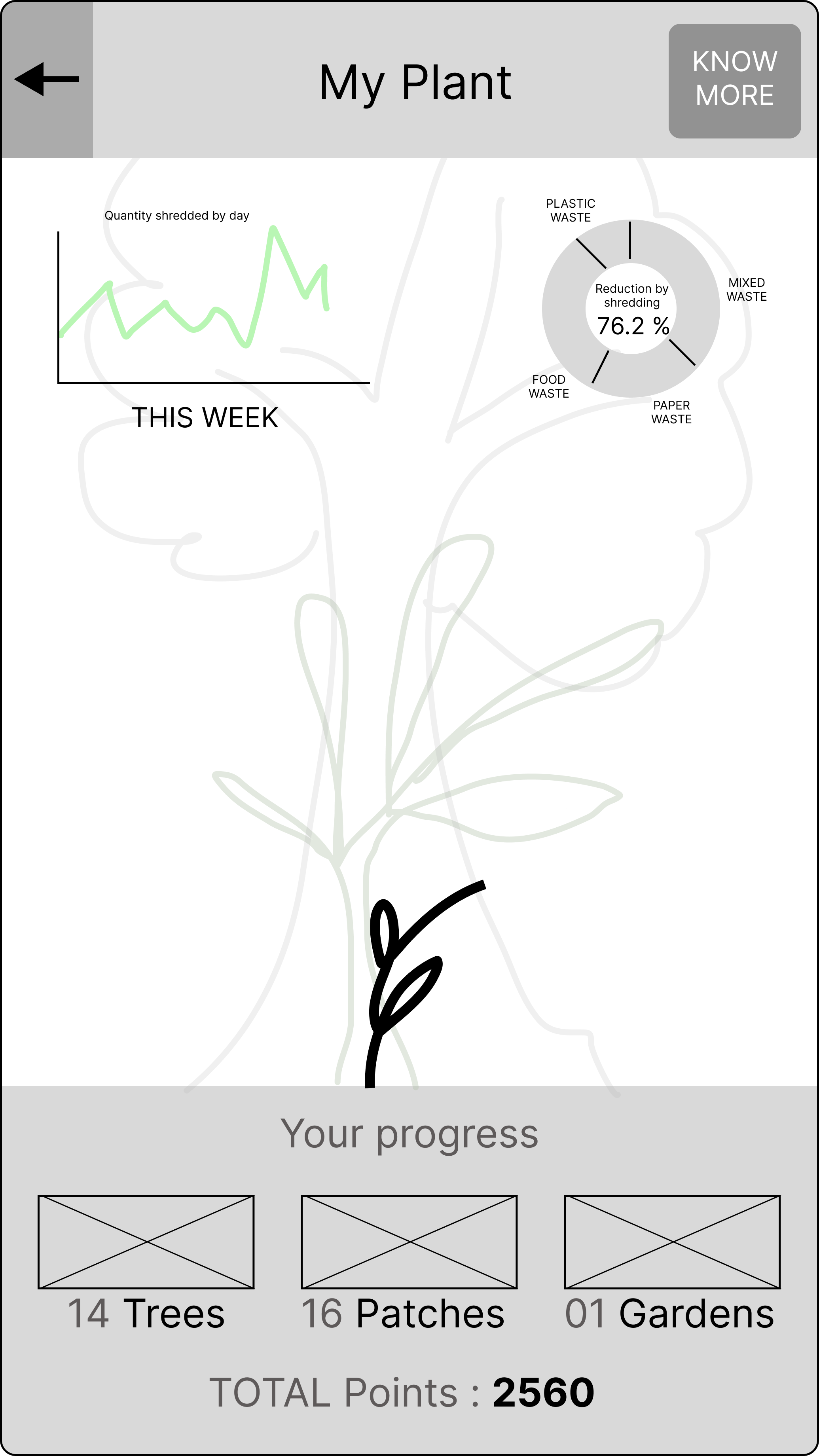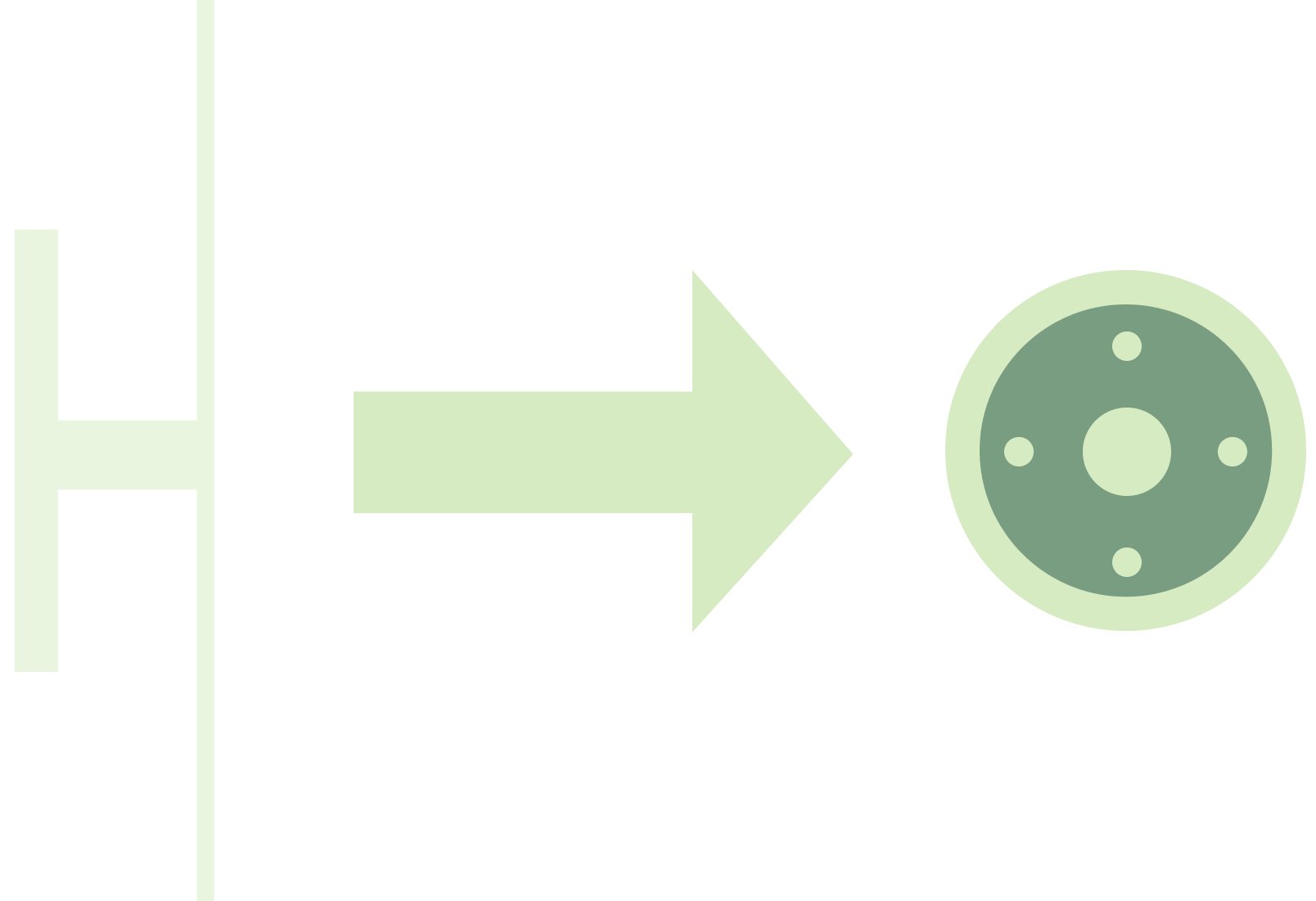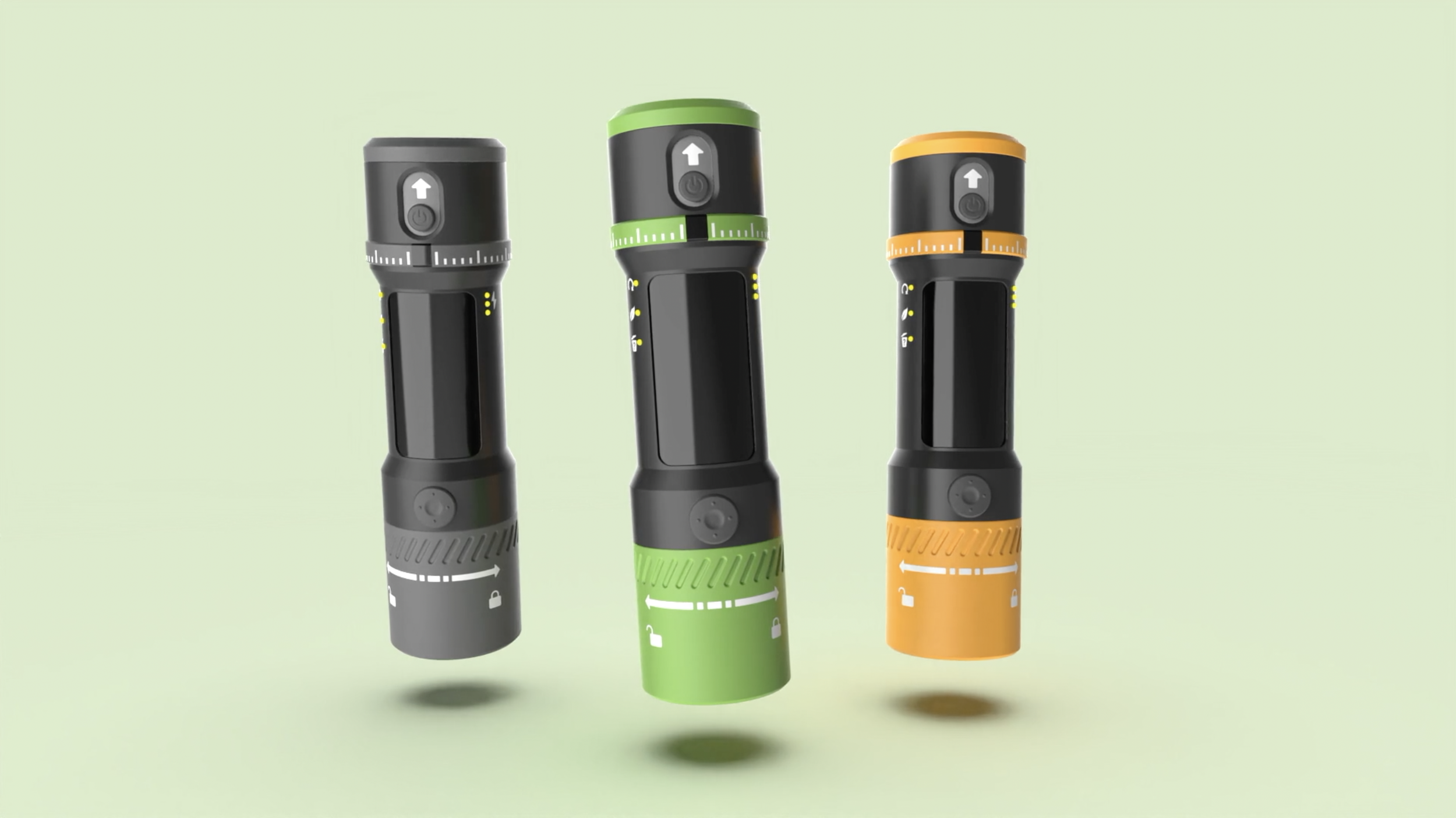
Project Binni
A portable smart bin that facilitates individuals’ on-the-go waste sorting in urban environment.
MY ROLE
USER RESEARCH LEAD
PRODUCT IDEATION
IDEA EVALUATION
PRODUCT TESTING
TIMELINE
October 2022 - January 2023
TEAM
2 DESIGNERS
3 RESEARCHERS
OUTCOMES
Conducted rigorous user research to inform the user persona, empathy map, user pain points, and user needs
Identified clear design opportunities to address the issue of individual waste management
Gathered and analysed user testing feedback to iterate on the product designs and functions
Context
The United Nations Sustainability Goals 11 and 12 stressed the significance of addressing waste management issues. However, many existing solutions focused only on developing new techniques targeting larger groups and communities. Individual users might experience difficulties when they try to dispose waste. As a result, we explored a solution that focuses on individual users’ waste management activities.
Design Process
User Research
As the user research lead, I led my team to establish and conduct our research methodologies.
Our user research explored the following questions:
What are some common types of waste produced by individuals?
How does user’s mood vary when they manage their waste?
What problems might user encounter during waste management?
Does waste management behaviour differ between different urban population groups?
How do individuals perceive their responsibility for domestic waste management?
What motivates individuals to manage waste?
Because of waste disposal’s ubiquitous nature, I wanted to understand these questions in both a broad and deep context. Therefore, I employed a combination of research methods that gave my team a holistic picture of users’ waste management behaviours.
Semi-Structured Follow-Up Interview
Large Scale Survey
ESM Diary Study
I ran a large-scale survey to gather a broad response from 80 participants of diverse backgrounds.
80 Survey Participants
China, India, United Kingdom, United States
4 Countries
In parallel to the large scale survey, I conducted an ESM diary study to establish an in-depth understanding of user’s waste disposal activities in their daily life.
5 Participants
Student
Student
Professional
Professional
Household Member
Participants completed one ESM diary entry every 2 hours
Each participant completed 6 ESM diary entries a day, providing together 60 valid responses in 2 days
Having collected the ESM diary results, I chose to run some follow-up interviews. Me and my teammates interviewed the five participants to further understand their perceptions, feelings, and motivations towards sustainable waste disposal, as well as the challenges they faced during the ESM diary study.
After the interview, me and my teammates created an affinity diagram to categorise interview keynotes into different groups, concluding 5 prominent themes:
Inaccessible bins are a ubiquitous issue
Sorting different kinds of wastes can be unclear and confusing
Soiled food packaging can negatively affect sorting behaviour
Mood, awareness and social perception affect waste management behaviour
Waste disposal is more complicated when outside
What Did Our Users Fear? What Did They Need?
Having completed the initial user research, me and my team moved on to establish our users’ pain points and needs. We summarised our findings from the survey, ESM diary study and follow-up interview to generate our target user’s persona and empathy map in a limited time session.
User Persona
Empathy Map
Based on the user persona, empathy map and our user research findings, we summarised:
Design Ideation
We ran a deep brainstorming session with regards to the 6 user requirements, ideating solutions in different areas, from robotics and AI to leveraging public transport.
Finally, our team came up with five design solutions to address the user pain points requirements. Our solutions were “EcoBus”, “Public Waste Sorting Kiosks”, “Portable Bin”, “Moving Bin”, and “Over-Ear AR Waste Sorting Headphones”.
Ideas Evaluation
We used multiple evaluation methods to assess our solutions, aiming to finally determine the best one for further iterations and refinements.
We employed the SWOT (Strength, Weakness, Opportunity, Threat) analysis as the first evaluation method to examine each design in different perspectives. Below showed the examples of the SWOT of the EcoBus and the Overhead AR Waste Sorting Headphones.
Since we wanted to take a user-centric design evaluation approach, we engaged with 5 participants to evaluate our design ideas. Participants expressed that if they thought the design would help them manage waste when out of home, if they would use the product, what they liked or disliked about the product, and more. Participants also ranked all products based on their preference.
And finally, we ran an in-team idea evaluation. For this evaluation we created a weighted criteria list, ranking the importance of different product characteristics based on their significance to our user requirements. Based on these characteristics and their priorities, we came up with a total score for every design idea.
In the end, based on the ratings from participants and within the team, we found that Binni stood out as the top-choice design solution. Therefore, we started working on Binni: a portable smart bin that facilitates individuals’ waste management activities when out and about in urban environments.
Designing Binni’s Functions
In order to let users quickly and effortlessly manage their waste when out of home, we introduced the “Auto Sort Mode” which uses an AR projector and camera to automatically scan and sort waste by highlighting them, users only need to follow the instructions.
As users also want to know how their behaviour can make an impact to the planet, we introduced the “Virtual Garden”. The virtual garden is in the form of a virtual plant which can grow from a seed to a garden. Users receive feedback that shows them their contribute to both the virtual plant and a better real-world environment. Users also receive points which can be used to redeem discount vouchers, achieving “positive reinforcement”.
Designing Binni’s Form Factor
In order to let users conveniently carry Binni, I proposed adding a magnet on top of Binni, and another magnet of the opposite polarity on users’ backpack, so that users can attach Binni to their backpack without occupying additional space.
As Binni is a SMART bin, I wanted to use a screen for interaction. I thought about using fingers for interaction, but what if users’ hands were dirty or wet? Later, I was inspired by the idea of using a joystick because it allows one-hand and even one-finger controls. I found that users’ usually grab Binni’s backside when holding it, I chose to put the joystick on the upper-part backside of Binni to enable easier interaction.
Here Comes the User Testing
The first round user testing provided us with a lot of useful insights. For my part of the design, I discovered that:
Participants didn’t find using the joystick intuitive enough. They were not used to finding a joystick on a non-gaming product
Participants thought that the joystick was not easy to use. Its positioning made it hard to be directly seen. Users had to turn Binni around all the time
Based on the feedback, I iterated on Binni’s design by:
Replacing the joystick with a D-Pad controller to enhance interaction intuitiveness
Putting the controller directly under Binni’s screen so that users can always see what they are doing with it
We also iterated on many other aspects of Binni:
An improved form factor that greatly reduced size and increased grip
Removed the “tuck them in” option on the screen to highlight the two waste sorting modes, promoting more frequent use of these modes
LED indicators for waste bags fill levels and Binni’s battery life
…and so much more
For the high-fidelity prototype user testing, we again recruited 6 participants. The user feedback received was inspiring. Users were very satisfied with the overall design of Binni. Specifically, our users reported that:
The overall interaction with Binni was fluid, intuitive and easy. This means that my iteration designs have been successful!
The form factor was very accessible. Users were confident that they could carry Binni all the time
The LED indicators was a powerful design that provided users with direct and intuitive feedback
The Final Product
And so, after two rounds of user testing, we have finally come up with a user-centred design solution that tackles the 11th and 12th United Nations Sustainability Goals and the issue of individual waste management. Our solution is Binni: a portable “smart” bin that facilitates individuals’ on-the-go waste sorting when out and about in urban environments.
“Auto Sort” Mode User Flow
“Manual Sort” Mode User Flow
Virtual Garden Access User Flow
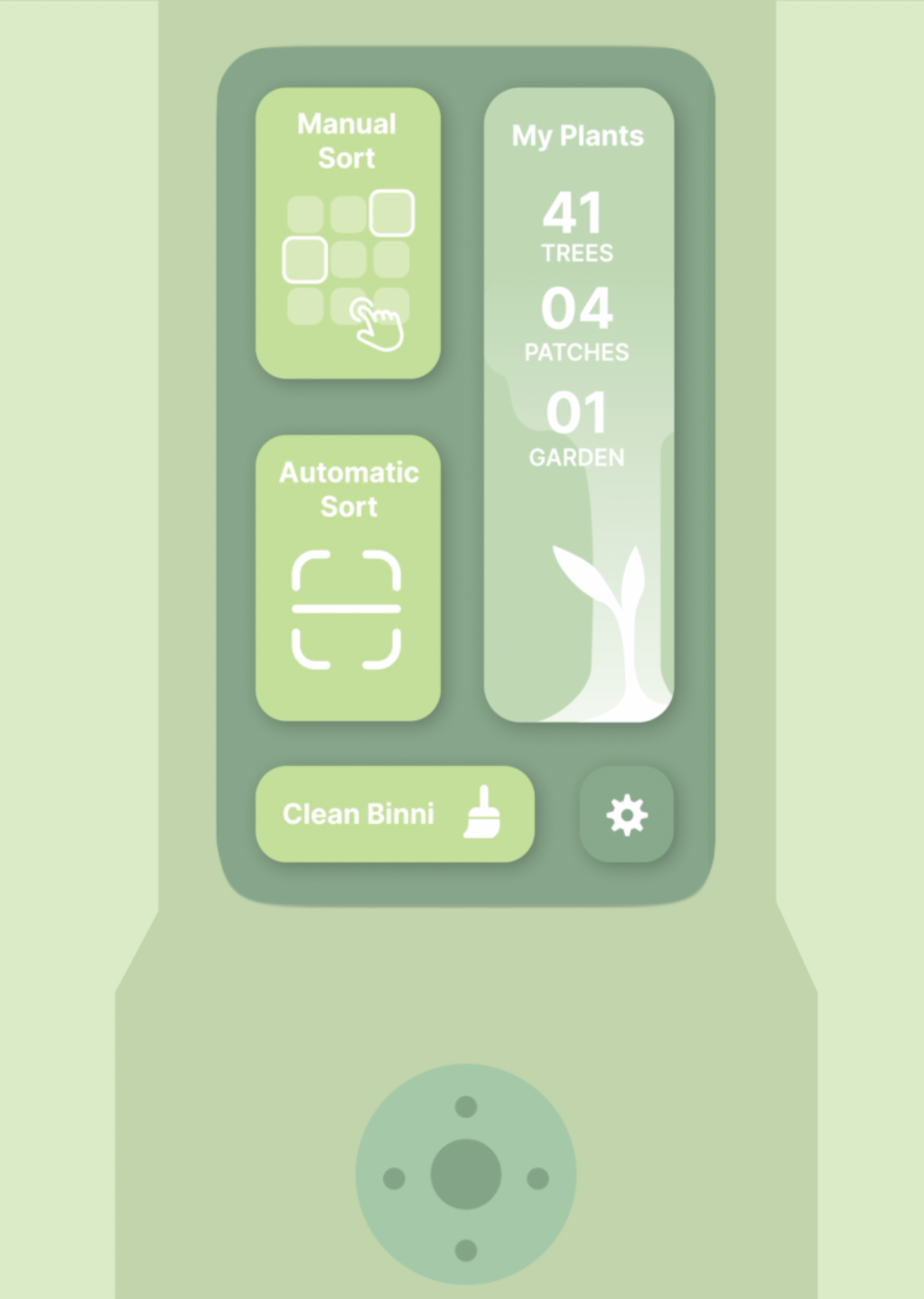
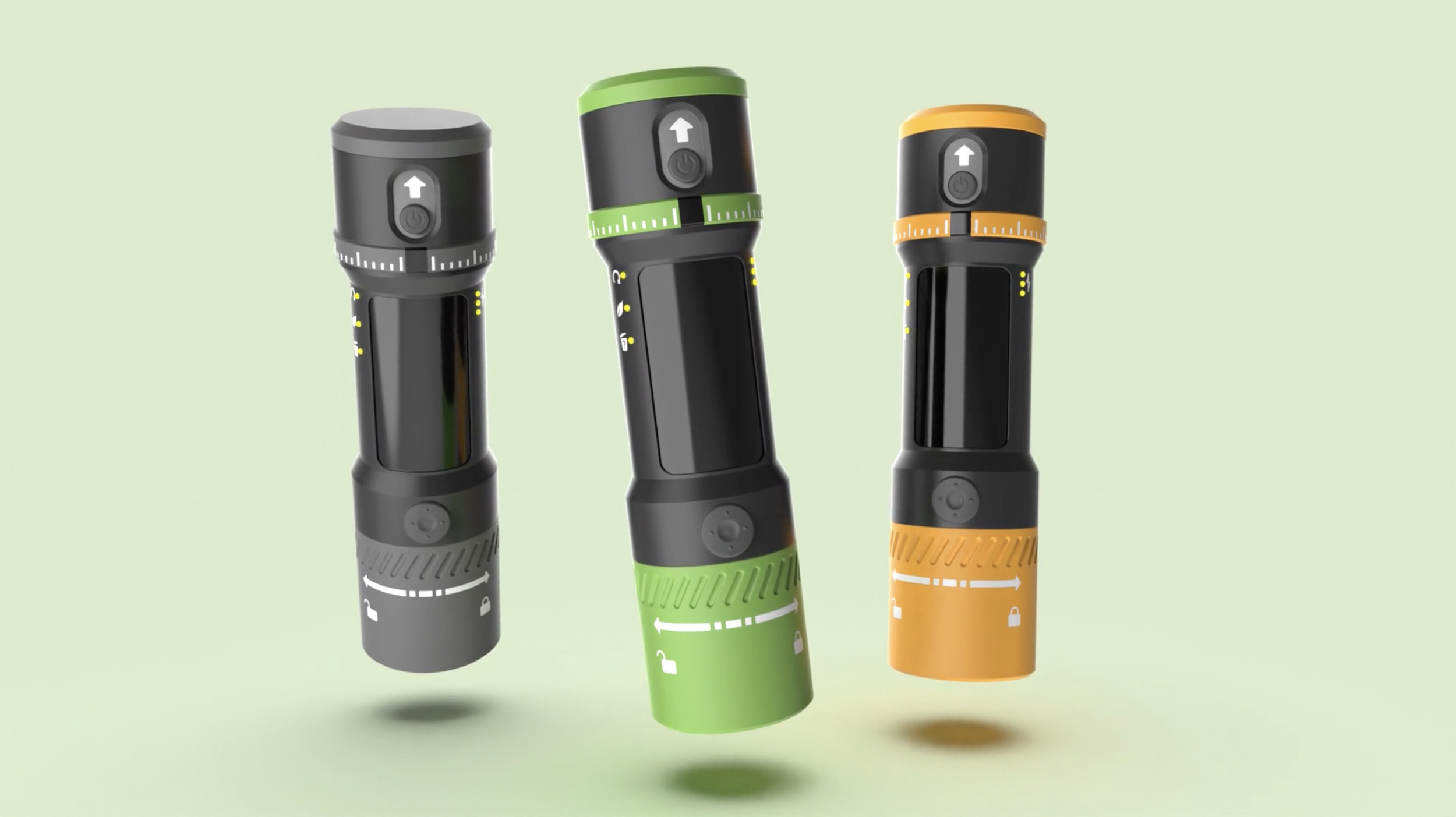
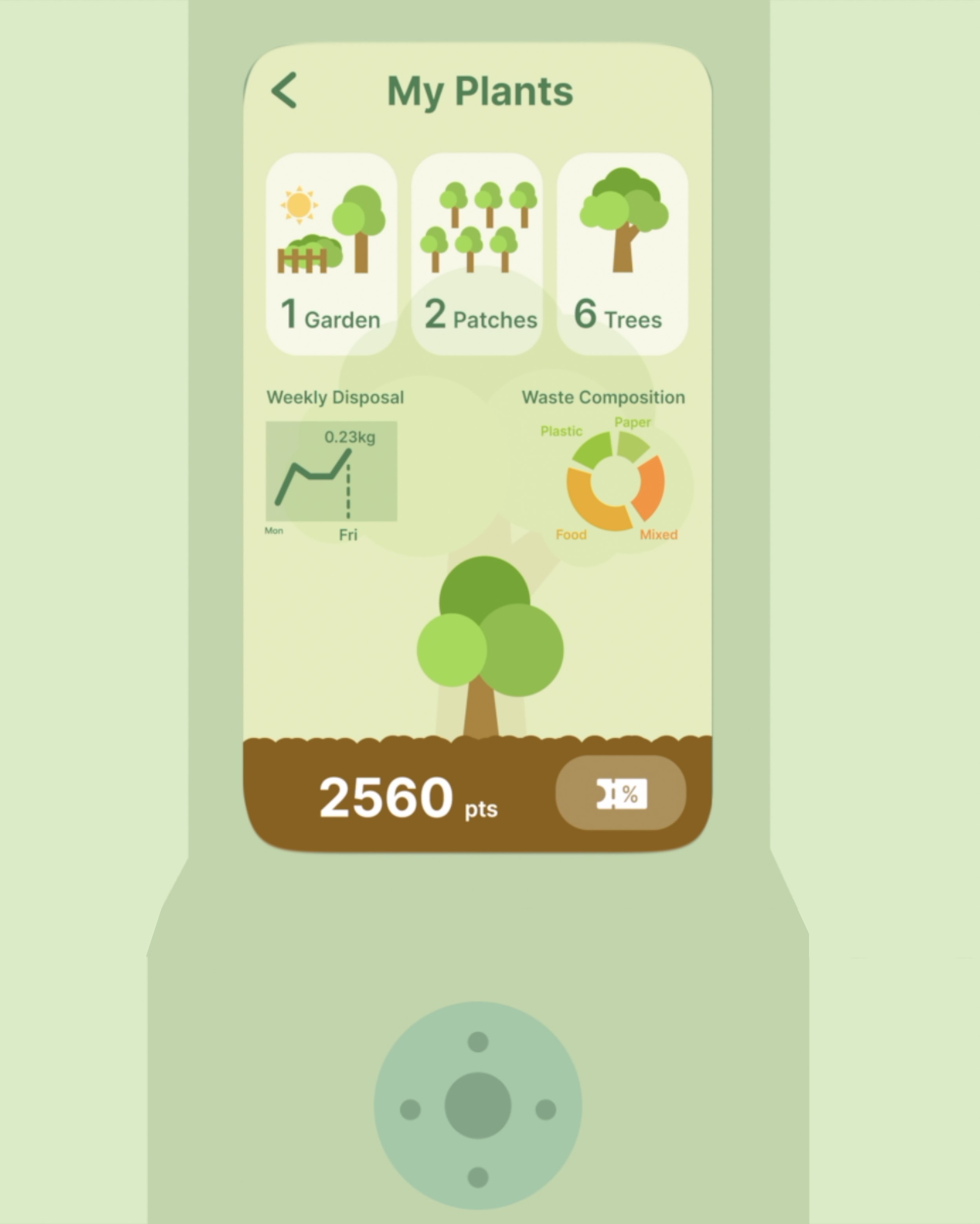
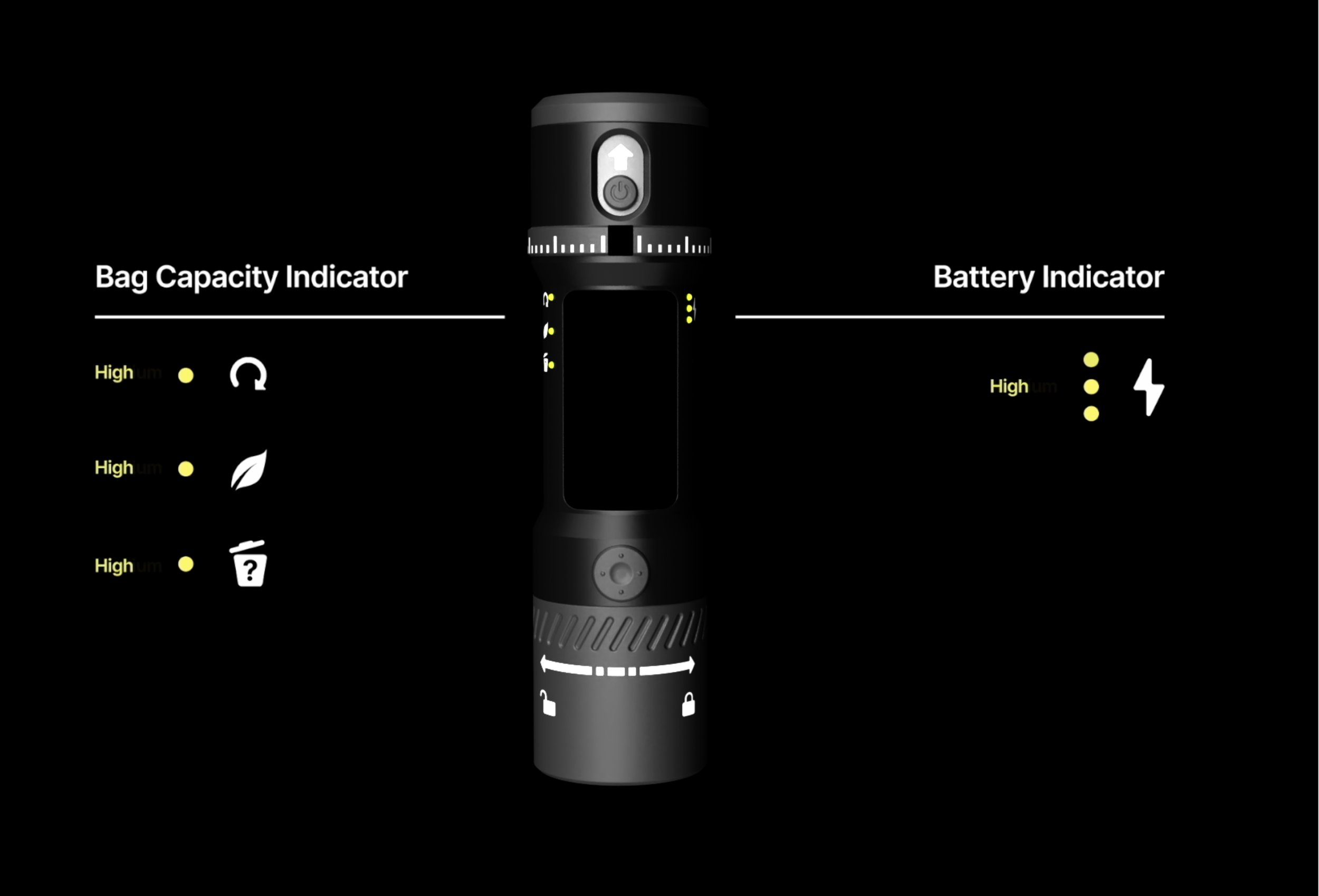
Check These Out!
If you would like to know more details about Binni, please watch this video!!!
But if you are interested in watching some funny moments……
Reflections
Creating a Product From the Beginning to the End Takes Time
For Binni, we thought about many different use scenarios, we tried to design every aspect of Binni in a user-centred way and to make Binni accessible to everyone. All these things took very careful planning, and they required time but more than just time to achieve.
Leading a Team is Harder than It Feels
I majored in psychology and I did user research before, but this was the very first time I led a user research. It was definitely a precious opportunity for me to learn and grow, but it was also a challenge. I needed to determine the appropriate research methods, explain to my team members what each method does, why I chose each method, and more. As the user research lead I gave feedback, I was responsible, and I was engaged. And although leading something was not very easy, it definitely was worth it.
Iterate! Iterate!
Sometimes we were reluctant to make more iterations because they were so mentally demanding and time consuming. But I believe that creating a wonderful product does take a lot of iterations, and that is the core of a UX designer: building everything in a user-centred way, and never stop making things better through improvements.























